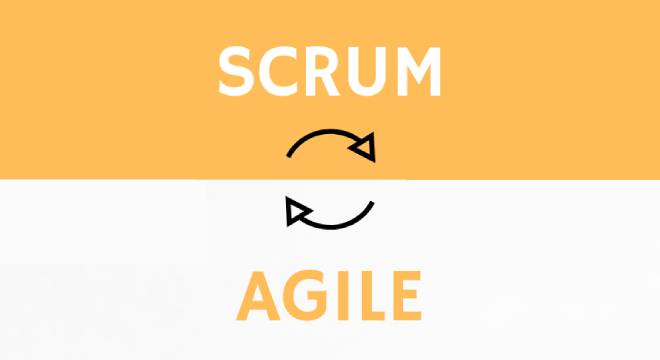
What is Agile Scrum Methodology and How Can it Help Your Startup?
October 12, 2022 - 5 min read
Nowadays, it’s more important than ever before to both be first and correct when it comes to product development.
But what to do to draw out your opponents on this slippery road?
If you have little bit interest on software development, you’ve probably heard the terms Agile and Scrum get thrown around.
Scrum Metodology is very different from traditional project management, known as the Waterfall Model. When building under the Waterfall Model, stakeholders only see the product when it’s finished and ready to launch. Scrum divides a project to small parts.
But we start from the beginning.
On this blog, we tried to give you information about Scrum & Agile and the things you should facilitate to fully benefit from it.
What is Agile Approach at Software Development?
Agile allows project teams to adapt to changing priorities, rapidly respond to problems as they arise and learn from frequent feedback from other product stakeholders – saving time and money.
It’s an approach to software development which based on breaking development down into smaller, shorter sprints.
According to that approach, frameworks have been developed to help software projects succeed. One of them, the most popular one, is Scrum.

What is SCRUM?
Scrum is a framework that teams can use to implement Agile.
If we keep it short, Agile is an approach to software development, while Scrum is one of the framework that fall under the Agile umbrella.
Scrum is built on delivery cycles known as “sprints” that generally last between one and four weeks. This system is designed to enable teams to deliver work incrementally that builds on the previous sprints’ work.
Scrum as being built on three key principles:
- Transparency – Complete project information access for all stakeholders
- Inspection – Continuous works to improve
- Adaptation – Quick refocus and adaptation
These three principles are backed up with five core values which all Scrum members should to embrace:
- Courage
- Focus
- Commitment
- Respect
- Openness
Scrum is the most common Agile methodology, like around %72 of Agile teams use Scrum , according to 15th State of Agile Report.
Before we move on to how Scrum can benefit a startup, check out a common Scrum team composition below.

The Agile Scrum Team
- Product Owner: The Product Owner (PO) is the single person responsible for maximising the value of what the development team produce.
- Development Team: Development Team are responsible for the execution of the work under the control of Product Owner.
- Scrum Master: The final vital member of the Scrum team is the Scrum Master. The Scrum Master is a self-organised advisor, there to make sure that sprints are being executed correctly by the above stakeholders facilitating Scrum theory within the team and supporting them.
How Agile Scrum Methodology can Benefit Your Startup?
Flexibility
The greatest benefit of Scrum methodology is, without a doubt, its flexibility. Due to its sprint-based approach, the Scrum team can gain regular feedback from stakeholders and, more importantly, users.
Meaning that every one to four weeks (depending on your sprint length) the team can easily adjust the product requirements according to feedback from users or customers and address their real needs.
More Valuable, Cost-Efficient
The team can adapt at a sprint’s notice, improving iteration by iteration to deliver a product that has the best chance of success as it is far more likely to address the users’ real needs due to their continuous feedback.
MVP (Minimal Viable Product)
As you know, most of the Startups do not have big capitals. As resources are limited, there is also not enough free time for exploration, troubleshooting and POC. For this reason, startups focus on results where they can go from investment to results quickly.
By giving top priority to the most critical parts of the product, the MVP approach can dramatically reduce time to market, providing competitive advantage and minimizing capital requirements.
Quick Learning & Release
Startups have limited asset availability. Their management has not enough spare time to explore, troubleshooting, and POC. Thus, they have to focus more on results rather than investment. The agile process has a little learning curve, easy to understand and implement. Likewise, Agile methodology helps them to learn, adapt and produce MVP quickly to the market.

Collaboration & Communication
Collaboration is an essential component of modern project management. Agile encourages collaboration at every level through stand-up meetings, sprint planning, and sprint review meetings. Agile teams create an efficient and collaborative workplace as well as leveraging individual strengths and ideas.
Result Oriented
For startups, results matter most. Agile development effectively tracks and records each sprint. As usual, any standard sprint takes two weeks to complete. Daily scrum meetings help the team to keep track of the sprint progress and remove hurdles. It also emphasizes that Agile development does not solely depend on the end result. Every iteration has a chance of improvement to the final product.
Summary
Scrum is outstanding when dealing with complex projects that are built in a changing environment.
It’s for this reason that it’s so well suited to early-stage startup products. If your product is innovative and you’re dealing with unchartered waters, Scrum gives you the flexibility to guide the product with precision as it matures.
More than this, early-stage startups often have a limited budget and runway. Again Scrum comes to the rescue. Scrum helps you ensure you’re only developing features that you know users want, thanks to the real-time feedback. This means you’re both:
- Building fewer features (reducing development time and cost)
- Building a higher quality product (as you won’t be adding unnecessary features that the user doesn’t want or need)
If you have any questions about Agile Scrum, and how to implement it in your startup, click here. We’ll be happy to answer any questions you may have.